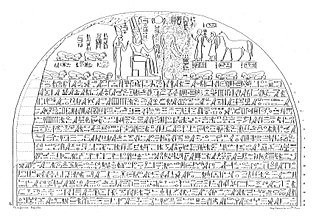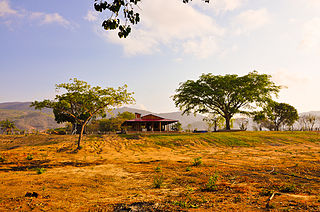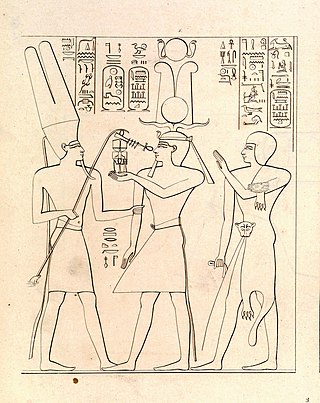
Hammurabi, also spelled Hammurapi, was the sixth Amorite king of the Old Babylonian Empire, reigning from c. 1792 to c. 1750 BC. He was preceded by his father, Sin-Muballit, who abdicated due to failing health. During his reign, he conquered the city-states of Larsa, Eshnunna, and Mari. He ousted Ishme-Dagan I, the king of Assyria, and forced his son Mut-Ashkur to pay tribute, bringing almost all of Mesopotamia under Babylonian rule.

Moses was a Hebrew prophet, teacher and leader according to Abrahamic tradition. He is considered the most important prophet in Judaism and Samaritanism, and one of the most important prophets in Christianity, Islam, the Baháʼí Faith, and other Abrahamic religions. According to both the Bible and the Quran, Moses was the leader of the Israelites and lawgiver to whom the prophetic authorship of the Torah is attributed.
This article concerns the period 729 BC – 720 BC.

The Middle Kingdom of Egypt is the period in the history of ancient Egypt following a period of political division known as the First Intermediate Period. The Middle Kingdom lasted from approximately 2040 to 1782 BC, stretching from the reunification of Egypt under the reign of Mentuhotep II in the Eleventh Dynasty to the end of the Twelfth Dynasty. The kings of the Eleventh Dynasty ruled from Thebes and the kings of the Twelfth Dynasty ruled from el-Lisht.

Piye was an ancient Kushite king and founder of the Twenty-fifth Dynasty of Egypt, who ruled Egypt from 744–714 BC. He ruled from the city of Napata, located deep in Nubia, modern-day Sudan.

Thutmose II was the fourth Pharaoh of the Eighteenth Dynasty of Egypt, and his reign is generally dated from 1493 to 1479 BC. Little is known about him and he is overshadowed by his father Thutmose I, half-sister and wife Hatshepsut, and son Thutmose III. He died around the age of 30 and his body was found in the Deir el-Bahri Cache above the Mortuary Temple of Hatshepsut.

An ejido is an area of communal land used for agriculture in which community members have usufruct rights rather than ownership rights to land, which in Mexico is held by the Mexican state. People awarded ejidos in the modern era farm them individually in parcels and collectively maintain communal holdings with government oversight. Although the system of ejidos was based on an understanding of the preconquest Aztec calpulli and the medieval Spanish ejido, since the 20th century ejidos have been managed and controlled by the government.
Lycurgus was the legendary lawgiver of Sparta, credited with the formation of its eunomia, involving political, economic, and social reforms to produce a military-oriented Spartan society in accordance with the Delphic oracle. The Spartans in the historical period honoured him as god.

Kamose was the last Pharaoh of the Theban Seventeenth Dynasty. He was possibly the son of Seqenenre Tao and Ahhotep I and the brother of Ahmose I, founder of the Eighteenth Dynasty. His reign fell at the very end of the Second Intermediate Period. Kamose is usually ascribed a reign of three years, although some scholars now favor giving him a longer reign of approximately five years.

The Prophecy of Neferti is one of the few surviving literary texts from ancient Egypt. The story is set in the Old Kingdom, under the reign of King Snefru. However, the text should be attributed to an individual named Neferyt, who most likely composed it at the beginning of the Twelfth Dynasty. The nature of the literary text is argued upon. There are a number of different theories stating that the literature is a historical romance in pseudo-prophetic form, political literature, religious motivation as well as a literary text created to change and improve the situation in Egypt during the Twelfth Dynasty.

Shepsesre Tefnakht was a prince of Sais and founder of the relatively short Twenty-fourth Dynasty of Egypt; he rose to become a Chief of the Ma in his home city. He is thought to have reigned roughly 732 BCE to 725 BCE, or seven years. Tefnakht I first began his career as the "Great Chief of the West" and Prince of Sais and was a late contemporary of the last ruler of the 22nd Dynasty: Shoshenq V. Tefnakht I was actually the second ruler of Sais; he was preceded by Osorkon C, who is attested by several documents mentioning him as this city's Chief of the Ma and Army Leader, according to Kenneth Kitchen, while his predecessor as Great Chief of the West was a man named Ankhhor. A recently discovered statue, dedicated by Tefnakht I to Amun-Re, reveals important details about his personal origins. The statue's text states that Tefnakht was the son of a certain Gemnefsutkapu and the grandson of Basa, a priest of Amun near Sais. Consequently, Tefnakht was not actually descended from either lines of Chiefs of the Ma and of the Libu as traditionally believed but rather came from a family of priests, and his ancestors being more likely Egyptians rather than Libyans.

Bakenranef, known by the ancient Greeks as Bocchoris or Bochchoris was briefly a king of the 24th Dynasty of Egypt. Based at Sais in the western Delta, he ruled Lower Egypt from c. 725 to 720 BC. Though the Ptolemaic period Egyptian historian Manetho considers him the sole member of the 24th Dynasty, modern scholars include his father Tefnakht in that dynasty. Although Sextus Julius Africanus quotes Manetho as stating that "Bocchoris" ruled for six years, some modern scholars again differ and assign him a shorter reign of only five years, based on evidence from an Apis Bull burial stela. It establishes that Bakenranef's reign ended only at the start of his 6th regnal year which, under the Egyptian dating system, means he had a reign of 5 full years. Bakenranef's prenomen or royal name, Wahkare, means "Constant is the Spirit of Re" in Egyptian.
Ancient Greek laws consist of the laws and legal institutions of ancient Greece.

Sekhemib-Perenma'at, is the Horus name of an early Egyptian king who ruled during the 2nd Dynasty. Similar to his predecessor, successor or co-ruler Seth-Peribsen, Sekhemib is contemporarily well attested in archaeological records, but he does not appear in any posthumous document. The exact length of his reign is unknown and his burial site has yet to be found.
Sekhemre Shedtawy Sobekemsaf II was an Egyptian king who reigned during the Second Intermediate Period, when Egypt was fragmented and ruled by multiple kings. He was once thought to belong to the late Thirteenth Dynasty, but is today believed to be placed as a king of the Seventeenth Dynasty of Egypt.

Before the 1910 Mexican Revolution, most land in post-independence Mexico was owned by wealthy Mexicans and foreigners, with small holders and indigenous communities possessing little productive land. During the colonial era, the Spanish crown protected holdings of indigenous communities that were mostly engaged in subsistence agriculture to countervail the encomienda and repartimiento systems. In the 19th century, Mexican elites consolidated large landed estates (haciendas) in many parts of the country while small holders, many of whom were mixed-race mestizos, engaged with the commercial economy.

Aakheperre Shoshenq V was an ancient Egyptian pharaoh of the late 22nd Dynasty.

The Bible makes reference to various pharaohs of Egypt. These include unnamed pharaohs in events described in the Torah, as well as several later named pharaohs, some of whom were historical or can be identified with historical pharaohs.

The Twenty-fourth Dynasty of Egypt is usually classified as the fourth Dynasty of the Ancient Egyptian Third Intermediate Period.

The Twenty-sixth Dynasty of Egypt was the last native dynasty of ancient Egypt before the Persian conquest in 525 BC. The dynasty's reign is also called the Saite Period after the city of Sais, where its pharaohs had their capital, and marks the beginning of the Late Period of ancient Egypt.















